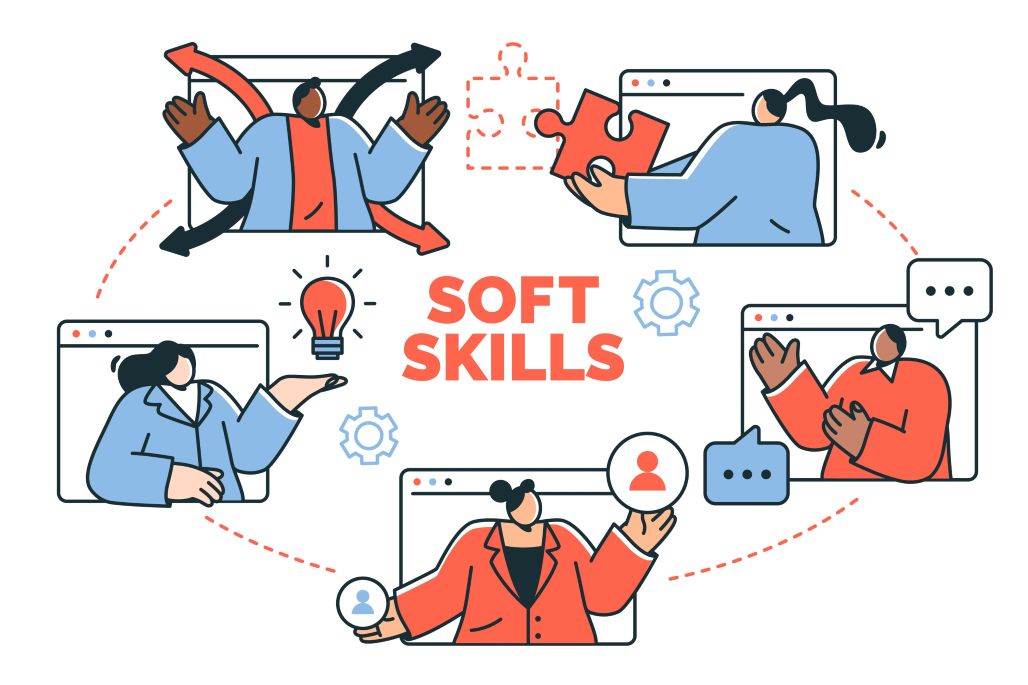
In 2025, technical skills alone won’t make your workforce stand out. The real differentiator? Soft skills—the ability to communicate effectively, collaborate seamlessly, solve problems, and adapt to change. Employees equipped with strong soft skills—such as communication, time management, and adaptability—are better positioned to navigate workplace challenges and contribute positively to team dynamics.
Research by Wiley Workplace Intelligence indicates that 63% of employees reported that soft skills development positively impacted their performance, while 51% found in-person training very or extremely effective, highlighting the importance of investing in these skills. For HR leaders, L&D teams, and instructional designers, curating the right soft skills training topic can transform productivity, engagement, and overall team performance. Thus, covering essential areas like soft skills training topics and productivity training topics helps employees work smarter and achieve better results.
Calibr provides comprehensive employee training, including soft skills training programs, ranging from free online courses to fully customized solutions that help employees develop skills that truly matter. Thus, the right soft skill training topic ensures that employees gain practical, role-specific skills that deliver measurable business outcomes .Ready to elevate your team’s performance with Calibr ? Visit our website or contact our team to explore how our training solutions can make a real difference.
Why Soft Skills Matter in Today’s Workplace
Soft skills are no longer optional—they are essential for organizational success. A well-prepared soft skills training topics list such as communication, teamwork, adaptability, and problem-solving ensures no critical area of development is overlooked and ultimately it helps drive collaboration, foster innovation, and enhance leadership effectiveness.
Organizations that invest in the right soft skills training topic see measurable improvements in productivity, employee engagement, and client satisfaction. Employees with strong soft skills can manage stress, resolve conflicts constructively, collaborate across teams, and contribute meaningfully to organizational goals.
According to the U.S. Department of Labor, soft skills such as communication, teamwork, and adaptability are essential for success in the workplace, influencing how employees interact with colleagues and contribute to organizational goals.Choosing a soft skill training topic aligned with these areas helps employees translate learning into real workplace impact.
By prioritizing soft skills development, organizations can build a future-ready workforce capable of thriving in a rapidly evolving workplace, maintaining high performance, and supporting sustainable business growth.
35 Key Areas to Strengthen Your Workforce
Curious which soft skills make the biggest impact? .Check out this list of soft skills training topics for employees to empower your workforce.

1. Communication Skills
Clear and effective communication is the foundation of every successful team. Focus on email etiquette, presentation skills, and active listening. Strong communication reduces misunderstandings, improves workflow, and ensures ideas are conveyed clearly. Example: A team that communicates effectively meets deadlines with fewer errors.
2. Emotional Intelligence
Teach employees to recognize and manage emotions, fostering better relationships and leadership skills. Emotional intelligence helps teams respond calmly to challenges and navigate workplace dynamics effectively. Example: A manager handling a tense client call with empathy.
3. Conflict Resolution
Train teams to handle disagreements constructively, maintaining collaboration and harmony. Conflict resolution prevents escalation, builds trust, and strengthens cohesion. Example: Mediating between two departments to reach a shared solution.
4. Critical Thinking
Encourage analytical thinking and better decision-making across roles. Employees who think critically can identify opportunities, evaluate risks, and propose effective solutions. Example: Analyzing project risks before implementation.
5. Problem-Solving
Equip employees with strategies to identify issues, analyze solutions, and implement actions effectively. Problem-solving skills enable teams to handle challenges independently, reducing bottlenecks. Example: Quickly resolving a supply chain disruption.
6. Leadership Development
Leadership skills are for everyone, not just managers. Cultivating future leaders strengthens resilience and ensures a strong talent pipeline. Example: Junior staff mentoring peers to build leadership capability.
7. Team Collaboration
Effective teamwork improves productivity. Cover virtual collaboration, cross-functional projects, and active participation. Collaborative teams share knowledge, streamline processes, and achieve collective goals faster. Example: A cross-departmental team launching a new product efficiently. Tools like Calibr support collaborative learning, enabling teams to share insights and learn together seamlessly
8. Adaptability and Flexibility
Prepare employees to navigate change confidently and maintain high performance. Adaptable employees embrace new processes and thrive in dynamic environments. Example: Quickly learning a new project management tool.
9. Time Management
Teach prioritization, scheduling, and productivity techniques. Efficient time management helps employees focus on high-impact tasks, meet deadlines, and reduce workplace stress. Example: Using time-blocking to finish high-priority projects. Tools like Calibr’s Microlearning feature can help employees master time management by delivering content in short, focused lessons that fit into their daily workflow.
10. Creativity and Innovation
Encourage innovative thinking and idea generation to solve problems and enhance products. Creative employees drive continuous improvement and help the organization stay competitive. Example: Brainstorming a new marketing strategy that boosts engagement.
11. Stress Management
Offer techniques to reduce workplace stress and maintain mental well-being. Stress management improves focus, prevents burnout, and promotes a healthier, more engaged workforce. Example: Mindfulness exercises during high-pressure projects.
12. Active Listening
Strengthen relationships by improving the ability to truly hear and understand colleagues and clients. Active listening fosters trust, enhances collaboration, and minimizes misunderstandings. Example: Paraphrasing a client’s concerns to ensure clarity.
13. Negotiation Skills
Train employees to achieve better outcomes while maintaining strong relationships. Strong negotiation skills help secure resources, resolve conflicts, and create win-win solutions. Example: Negotiating vendor contracts that save costs while maintaining quality.
14. Customer-Centric Mindset
Essential for client-facing teams, emphasizing empathy, patience, and problem-solving. Employees with a customer-focused mindset improve satisfaction, loyalty, and business growth. Example: Proactively solving a customer issue before it escalates.
15. Public Speaking
Boost confidence in delivering presentations, pitches, and team meetings. Effective public speaking enhances credibility, influences audiences, and strengthens leadership presence. Example: Presenting quarterly results confidently to the executive team.
16. Workplace Etiquette
Teach proper professional behavior, including digital etiquette and cross-cultural sensitivity. Etiquette skills foster respect, reduce friction, and improve collaboration in diverse teams. Example: Maintaining professionalism in video calls.
17. Feedback and Coaching
Enable employees to give and receive constructive feedback effectively. Strong feedback culture drives continuous improvement, engagement, and personal development. Example: A manager providing actionable feedback during a project review.
18. Decision-Making
Train staff to evaluate options and make informed, timely choices. Good decision-making leads to better resource allocation, problem resolution, and achievement of organizational goals. Example: Choosing the most effective marketing channel based on data.
19. Self-Motivation
Encourage proactive behavior and personal accountability. Self-motivated employees take initiative, show resilience, and consistently drive results without supervision. Example: An employee independently learning a new skill relevant to their role.
20. Cultural Competence
Promote diversity awareness and sensitivity in multicultural teams. Cultural competence fosters inclusion, reduces bias, and strengthens global collaboration. Example: Adapting communication style for an international client.
21. Influencing and Persuasion
Key for leadership, sales, and project management roles. Employees with influencing skills can inspire, motivate, and gain support for ideas or initiatives. Example: Convincing stakeholders to adopt a new process.
22. Interpersonal Skills
Enhance collaboration, empathy, and relationship-building. Strong interpersonal skills improve teamwork, reduce conflict, and create a positive work environment. Example: Building rapport with a cross-functional team member.
23. Accountability
Instill ownership and responsibility for tasks and outcomes. Accountable employees are reliable, deliver results consistently, and contribute to organizational trust. Example: Taking responsibility for a missed deadline and proposing corrective steps.
24. Resilience
Train employees to recover from setbacks and maintain productivity under pressure. Resilient teams are adaptable, maintain morale during challenges, and sustain long-term performance. Example: Staying productive after a failed project iteration.
25. Mindfulness and Emotional Balance
Introduce techniques to improve focus, reduce stress, and enhance well-being. Mindfulness fosters concentration, thoughtful decision-making, and overall workplace wellness. Example: Practicing short mindfulness exercises before client meetings.
26. Conflict Management for Leaders
Specialized training for managers to handle workplace disputes effectively. Leaders who manage conflict well create a safe, productive, and collaborative environment. Example: Mediating disputes between team members to maintain harmony.
27. Negotiation and Assertiveness
Help employees balance assertiveness with maintaining positive relationships. Assertive negotiators communicate needs clearly without damaging rapport. Example: Requesting resources assertively during a project kickoff.
28. Coaching and Mentoring
Develop leaders capable of guiding and nurturing talent. Effective coaching boosts employee growth, engagement, and knowledge transfer across teams. Example: Senior employees mentoring new hires for faster onboarding.
29. Digital Communication Skills
Adapt communication skills for remote and hybrid work environments. Digital proficiency ensures clarity, reduces miscommunication, and maintains engagement across virtual teams. Example: Writing concise, clear messages in collaboration tools.
30. Presentation and Storytelling
Teach employees to convey ideas persuasively and engagingly. Strong storytelling enhances impact, inspires action, and improves audience understanding. Example: Using narratives to make a project proposal memorable.
31. Networking Skills
Facilitate meaningful professional relationships internally and externally. Networking drives collaboration, knowledge sharing, and career growth opportunities. Example: Building connections with colleagues across departments for project success.
32. Innovation Mindset
Cultivate curiosity, experimentation, and a continuous improvement culture. Innovative employees contribute to new solutions, processes, and business opportunities. Example: Suggesting a new workflow that reduces team bottlenecks.
33. Emotional Agility
Help employees navigate emotional challenges with adaptability and composure. Emotional agility supports stress management, resilience, and effective collaboration. Example: Remaining calm and flexible during unexpected project changes.
34. Cross-Functional Collaboration
Strengthen teamwork across departments for better project outcomes. Collaboration across functions encourages knowledge sharing, efficiency, and innovation. Example: Product, marketing, and sales teams working together to launch a campaign.
35. Continuous Learning
Encourage employees to embrace lifelong learning and upskilling initiatives. Continuous learners stay competitive, adapt to change, and contribute to organizational growth. Example: Enrolling in online courses to stay ahead in industry trends.
Thus, by following a clear list of soft skills training topics for employees like listed above, organizations ensure learning paths remain structured and impactful.
Benefits of Soft Skills Training
Boosted Productivity & Higher Engagement
Employees equipped with strong soft skills—like communication, time management, and adaptability—collaborate more effectively and navigate workplace challenges with confidence. A well-chosen soft skills training topic also fosters motivation and job satisfaction, creating a more engaged workforce. In fact, research by Everything DiSC shows that employees who undergo soft skills training topics for employees report measurable improvements in performance and engagement. Including productivity training topics ensures employees learn time management, prioritization, and focus strategies that directly impact performance.
Improved Customer Experience
Strong interpersonal skills—like empathy, active listening, and problem-solving—enable employees to understand and meet customer needs effectively. This results in higher client satisfaction, stronger loyalty, and long-term business growth. Employees trained in these skills can anticipate challenges and provide proactive solutions, enhancing the overall customer experience. Choosing the right topics for soft skills training ensures employees are prepared to deliver exceptional customer interactions.
Future-Ready Leadership
Soft skills development prepares employees for leadership by improving decision-making, mentoring, and adaptability. It also helps leaders inspire teams, manage conflicts, and foster innovation through creative problem-solving. Employees with these skills can build inclusive workplace cultures, communicate vision clearly, and guide teams confidently toward organizational goals. By embedding soft skills training topics for employees into ongoing development programs, organizations ensure leaders are ready for the challenges of tomorrow.
Key Takeaways
Investing in soft skills training topics for employees is more than a nice-to-have—it’s a strategic advantage for organizations aiming to stay competitive and future-ready. Teams strong in communication, leadership, collaboration, and adaptability demonstrate higher productivity, engagement, and effective problem-solving. Employees with well-developed soft skills navigate challenges, build stronger relationships, and contribute meaningfully to organizational goals.
Companies can start with free soft skills training topics for employees to explore concepts like communication, emotional intelligence, and teamwork. As programs grow, learning platforms like Calibr empower HR leaders, L&D teams, and instructional designers to deliver, track, and measure impact while personalizing learning paths to each role. Start your journey today—sign up for 14-day free trial and see how easy it is to transform learning.
The real value of a clear soft skills training topics list lies in its practicality. Engaging, scenario-based programs boost confidence in managing conflicts, leading projects, mentoring peers, and adapting to change, strengthening overall organizational resilience. By prioritizing these skills, organizations build a workforce capable today and ready for the challenges of 2025 and beyond.
With Calibr, teams can deliver measurable results, track completion, and reinforce learning continuously—ensuring skills stick. Want to see it in action? Contact Calibr or schedule a personalized demo and explore how your organization can elevate employee performance.
Invest in soft skills today, and the returns will be higher engagement, stronger culture, and sustained business growth.


